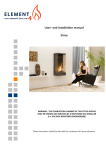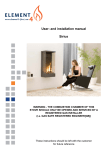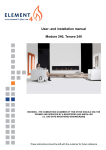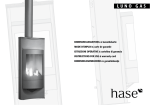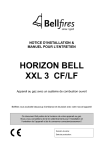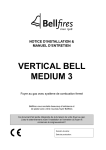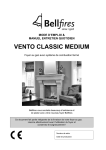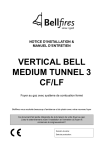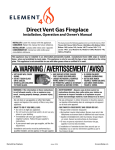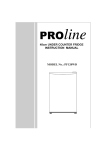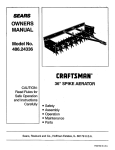Download User- and installation manual Vesuvius 100, Vesuvius 140
Transcript
User- and installation manual Vesuvius 100, Vesuvius 140 WARNING - THE COMBUSTION CHAMBER OF THIS STOVE SHOULD ONLY BE OPENED AND SERVICED BY A REGISTERED GAS INSTALLER (i.e. GAS SAFE REGISTERED ENGINEER[GB]) These instructions should be left with the customer for future reference This Manual Covers the following appliances: Vesuvius 100, Vesuvius 140 Contents GENERAL INFORMATION............................................................................................................3 Important Safety Notice..................................................................................................................3 General Fitting Information....................................................................................................4 USER INFORMATION...................................................................................................................5 Remote Control Electronic Ignition System RCE GV60................................................................5 INSTALLER INFORMATION.......................................................................................................10 Ventilation............................................................................................................................10 General Balanced Flue Notes / Appliance Fireplace installation.........................................10 Terminal Locations Wall Mounting.......................................................................................12 Terminal Locations Roof Termination...................................................................................13 Concentric Flue Parts Identification.....................................................................................14 Rigid Balanced Flue Connection Possibilities......................................................................21 Vertical Roof Terminations...................................................................................................22 Installing Remote Control Electronic Ignition System GV60........................................................25 Arranging The Ceramic Fire-bed..................................................................................................26 Log Arrangements...............................................................................................................24 Gravel Arrangements...................................................................................................................30 COMMISSIONING THE APPLIANCE..........................................................................................30 Installation tips.............................................................................................................................31 Installing the fire .........................................................................................................31 Servicing Instructions...................................................................................................................34 Troubleshooting............................................................................................................................34 TECHNICAL INFORMATION.......................................................................................................37 Dimensions..................................................................................................................................37 Technical Details..........................................................................................................................39 Warranty.......................................................................................................................................42 GENERAL INFORMATION Important Safety Notice ing regulations. It is therefore recommend that a registered gas installer be employed for this This appliance has a ceramic Fire-bed arrangement; this contains Refractory Ceramic Fibres, which are man-made vitreous silicate fibres. Excessive exposure to these materials can task. The engineer will provide you with information about the safety limits of the installation and should fix a notice plate in a place where it can be readily seen. cause irritation to eyes, skin and respiratory organs. Hence we recommend that when handling these materials the release of dust should be kept to a minimum. During installation and servicing we recommend that a HEPA filtered This appliance is designed as an efficient heating device and consequently all body parts become very hot in use. Except for the control knob and control access door, which are designed to stay cool, all other parts are working surfaces and should not be touched. vacuum be used to remove any dust and soot in and around the fire. If any of the ceramic fire-bed components need to be replaced we recommend that the removed parts be sealed in a heavy-duty polythene bag, and be labelled as RCF waste. RCF is not “Hazardous waste” and The glass and frame on this appliance acts as a fireguard conforming to BS: 1945 – 1971 and satisfies the Heating Appliance (Fireguards) regulations 1991. No part of the window or frame should be permanently removed. It does not give protection for young children aged or infirm, extra guarding(conforming to BS8423: can be disposed of at a licensed tipping site for the disposal of industrial waste. The appliance incorporates a permanent pilot. This is located on the front of the burner, and 2002) should be considered so the special hazards that exist in nurseries and other places where there are young children, aged or infirm persons are minimized. must not be adjusted by the installer. This system must not be put out of operation, and if any parts require changing, only original manufacturer parts shall be used. Bearing in mind that the heat given off by this This appliance is designed to be used either Natural or LPG gas however, each individual appliance may affect articles placed close to it, curtains should not be placed within 30cm. appliance is only capable of running off the type of gas specified at the time of purchase. It is important to note that once a type of gas has been The appliance is not designed as a dryer. It is not therefore recommended that the appliance be specified the stove cannot run off any other type. The type of gas that your stove is capable of used in such a manner. Do not place any articles within 30cm of this appliance as this may result in damage to the articles. burning is stated on the data information panel. The installation must be carried out in accordance with the following regulations: This appliance has been designed, tested and approved to meet standards in place for product use, performance and safety. Installation of your appliance must comply with current build- The Building Regulations issued by the Depart3 GENERAL INFORMATION General Fitting Information ment of the Environment, the Building Standards (Scotland) (Consolidation) Regulations issued Inlet pipe connection 8mm compression Chimney requirements Balanced Flue by the Scottish Development Department. Flue monitor BS 5440 part 1, BS 5871 part 2 and BS 6891. Permanent Pilot User control: Variable rotary control inc. integrated Piezo ignition, Permanent pilot facility, Flame failure device and Oxygen Depletion Cut-out. In the Republic of Ireland the installation must also conform to the relevant standards, particularly in regard to flue sizing and ventilation. Refer to documents IS813, ICP3, IS327 and any other Before installation of these appliances, the area into which the fire is to be fitted must be cleared of all debris (including dust), in particular combustible material. rules in force. This appliance must be installed in accordance with the rules in force and used only in a sufficiently ventilated space, and is intended for use on a gas installation with a governed meter. The appliance must sit on a hearth (or base surface) sufficient to support the weight of the fire. The firebox must then also be secured. Adjustable brackets are supplied on the firebox for this purpose. Before installation, ensure that the local distribution conditions (identification of the type of gas and pressure) and the adjustment of the appliance are compatible. The technical specification of this appliance is given on the rear page of this manual. Do not use the appliance if the glass front door or panel has been broken, removed or is open. Note: Since the appliance is a source of heat, circulation of air occurs. Therefore it is of importance that you do not use the appliance shortly after a renovation of the home. Because of the natural circulation of air, moist and volatile components from paint, building materials, carpet etc. will be attracted. These components can settle themselves down onto cold surfaces in the form of soot. 4 user information Remote control electronic ignition system RCE GV60 - temperature display in degrees Celsius or Fahrenheit; - time; - thermostat function; The appliance is supplied with a remote control. Ignition, controlling the flame height and switching off are performed by the remote control that operates a receiver in the control hatch. For some appliances, no control hatch is supplied. In that case, the receiver is placed under the - timer for thermostat function. Setting the communication code Prior to putting the application into operation, a communication code must be set between the remote control and the receiver. The code is chosen randomly from the 65000 available codes. As a result, the chance that other remote controls near you are using the same code and affect the operation of your appliance is very small. appliance. The receiver and remote control are battery powered. The receiver requires 4 penlite (AA type) batteries, the remote control requires a 9V block battery. At normal use, the batteries will have an average life of one year. You can also use an optional adapter. Ask your installer for information. In that case you will need a 230 V connection near your appliance. Follow the procedure described below: Hold down the reset button on the receiver, until you hear two consecutive sound signals (see fig. 2). After the second, longer signal, let go of the reset button. (small flame) or button Press button ( large flame) on the remote control within 20 1 seconds, until you hear an extra long sound signal: this is the confirmation of a correct communication. !Caution When installing a new remote control or receiver, you must set a new communication code. 2 The appliance’s standard functions such as ignition, controlling the flame height, standby (pilot burner) position and switching off are performed in the MAN position, the manual control of the remote control (see fig. 2). In addition, the remote control can also be used to set a number of additional functions: 5 user information MAN position By briefly pressing the SET button, you will go Ignite the appliance as follows: Set button A on the gas control to through the following functions: MAN → TEMP → TEMP → (P*)TIMER ON (button B is controlled automatically). → MAN where, depending on the timer setting: (P*) is displayed as P1 , , P1 , P2 P2 . The gas control is located in the control hatch or is placed under the appliance. , Simultaneously press the buttons OFF and (large flame) on the remote control. Let go of the buttons when a short sound You can also go back to the MAN position by pressing the button (small flame). (large flame) or signal indicates that the ignition process has been started. In succession: - the continuous signals will indicate that the ignition process is active; - a short sound signal will indicate that the igni- !Caution - When pressing the buttons (with the exception of the SET button), the transmission symbol ( ) will appear to indicate that transmission is taking place between the remote control and the receiver; - The receiver acknowledges the transmission with a sound signal; - The appliance will automatically enter the tion process has finished; - the appliance will automatically switch through to the highest position of the main burner, which will start to burn in a few seconds. standby position, if there is no transmission for 6 hours. Set the remote control to the MAN position. Caution - If the pilot burner is not burning after 3 ignition attempts, you must close the gas tap and call the installer; - When igniting the pilot burner, you will hear Ignition sound signals. After the last short sound signal, the main burner should be largely Caution - During the ignition process, you are not allowed to operate control button B on the gas control manually - Always wait 5 minutes after the pilot burner has gone out, before you re-ignite ignited within about 10 seconds. If this is not the case, you must close the gas tap and warn your installer; - If the appliance ignites with a pop sound, you must close the gas tap and the appliance; contact your installer. 3 !Tip A little motor will start to run when the main burner operates, you will be able to hear it. A B 6 user information Flame height / standby Time The flame height can be adjusted continuously by using the buttons (small flame) and (large flame). By continuing to lower the flame height, the appliance can be set to the standby position; The display can indicate time. After placing the battery or simultaneously press(large flame) and (small flame), the ing time indication will flash on the display and you this means that only the pilot burner will still be burning. Press button (small flame) to lower the flame height and/or to set the appliance in the standby position. Press the button (large flame) to raise the will be able to adjust the time. Simultaneously press and until the time indication flashes on the display. Press the button (large flame) to set the hours. flame height and/or to switch on the main burner from the standby (pilot burner) position. Press the button (small flame) to set the minutes. Press OFF to return to the MAN position, or wait for the system to automatically return to the MAN position. Caution - If you continue to press down button (large flame) on the remote control, the main burner should be largely ignited within about 10 seconds. If this is not the case, you must close the gas tap and warn your installer; Thermostat function Using the thermostat function you can set two temperatures, which can be controlled thermostatically. These temperatures are referred to as day temperature and night - If the appliance ignites with a pop sound, you must close the gas tap and contact your installer. temperature. The TEMP and TEMP symbols on the display refer to day and night temperature respectively. Switching off Switch the appliance off by pressing the OFF button. The pilot burner will also go out. The room temperature is compared to the set day/night temperature and then the flame height Temperature display The room temperature can be indicated on the display in degrees Celsius (°C) using a 24 hour clock or degrees Fahrenheit (°F) using a 12 hour clock. Simultaneously press OFF and (small flame), until the correct display appears. is automatically controlled in order to reach the set temperature. To be able to use the day/night temperature function, the appliance must be in the standby position. !Caution - Always leave the remote control at the same place, so that the thermostat is able to ‘feel’ the room temperature; - Make sure this place is free from influences such as draught, heat from radiators and direct sunlight. 7 user information Timer for thermostat function Using the timer enables you to set two times per 24 hours for switching on the day temperature and two times per 24 hours for switching on the night temperature. In order to control the night temperature, it should be set to at least 5 °C / 40 °F. If the night temperature is set to the “-- ” position, the appliance will remain in the standby position. The appliance will only switch on at the next switch-on time of the day temperature. The appliance must be in standby position in order to be controlled by the timer. Example By using the Y TEMP function you can keep the day temperature at 20 °C; while you use the 4 TEMP function at night to maintain a temperature of 15 °C. Setting day/night temperature By using the SET button, you will go through the following functions: MAN → TEMP → TEMP → (P*)TIMER → MAN Briefly press the SET button to enter the TEMP or the TEMP position. Press the SET button until the temperature on the display flashes. Set the required temperature by using the buttons (large flame) and (small flame). !Caution - The minimum temperature you can set is 5 °C / 40 °F; - Control of the night temperature is switched off by lowering the temperature until two stripes (“--”) appear on the display. Press the OFF button or wait until position TEMP or TEMP appears on the display. Example of switch times You have set a day temperature and night temperature of, for example, 20 °C and 15 °C. P1 TIMER = 7 hours; the temperature will go to 20 °C at 7 am. TIMER = 9 hours; the temperature will P1 go to 15 °C at 9 am. P2 TIMER = 17 hours; the temperature will go to 20 °C at 5 pm. P2 TIMER = 22 hours; the temperature returns to 15 °C at 10 pm. Activating the thermostat function For activating the thermostat function, you must proceed with the following steps: Place the appliance in the standby (pilot burner) position using button (small flame). Set the day/night temperature. Choose the TEMP or TEMP function using the SET button. 8 user information Replacing the battery If the battery is almost empty, the display will show “BATT”. Setting times for the timer To set the timer, proceed as follows: Set the day and night temperature as described above Briefly press the SET button to enter the (P*) TIMER position. Press the SET button until P1 TIMER is displayed and the time flashes. Set the first switch on time of the day temperature (large flame) and (small using the buttons flame). Briefly press the SET button to set the next time of the cycle, P1 TIMER. Successively set the times P2 TIMER and P2 TIMER. Press the OFF button or wait until position (P*) TIMER appears on the display. To replace the battery, proceed as follows: Remove the cover at the back side of the remote control. Disconnect the 9V block battery from / connect the 9V block battery to the connector. !Caution - Observe the “+” and “-” poles of the batteries and the connector; - Use alkaline batteries; - Batteries are regarded as “small chemical waste” and may therefore not be disposed with the household rubbish. Place the battery in the holder. Replace the cover. Activating the timer function Follow the steps below for activating the timer control: Place the appliance in the standby (pilot burner) position using button (small flame). Set the day/night temperature if you have not yet done so; Set the timer times P1 TIMER, P1 TIMER, P2 TIMER and P2 TIMER. Choose the (P*) TIMER function using the SET button. 9 installer information Installation restricted to the Flue systems as specified by the supplier, thus the appliance must only be installed with the original flue system, no others may be used The gas fire, in combination with the concentric flue system , has been approved in accordance with the European CE-norm for gas appliances and may therefore be used only with this system. The guarantee is invalidated if the appliance is (completely or partially) installed using a different system. Before beginning the installation, check that the details on the rating plate correspond to the gas type and pressure to which the appliance will be connected. Ventilation This appliance can be installed in a completely sealed or mechanically ventilated house without extra ventilation and/or fume extraction. The concentric flue systems can be used with either a newly-built or existing chimney. General Balanced Flue Notes These appliances are designed with the “Firebox” raised up off the ground level by the built in “Base unit”. There are many possibilities for installing this Concentric Balanced Flue system into a building, both Roof and Wall terminations are possible, and the flue can either be built into an existing chimney or a completely new flue system may be constructed. Thus these appliances require no special Hearth arrangements, as the floor will not get hot and is protected by the steel construction of the “Base unit”. The system is based upon a Concentric Flue system which utilises an inner flue of 100 or 130 mm diameter which passes through an outer flue of 150 or 200 mm diameter. The flue gasses that are the products of combustion of the fire, pass through the inner flue and are safely vented to the outside environment. The gap between the inner and outer flues is the channel by which the stove is supplied with air for combustion. The appliance must not be fitted against a rear wall constructed from a combustible material; a gap of 300mm should be given all round the stove before combustible materials may be used in the wall construction. If the appliance has to be located in an opening, a minimum clearance of 50mm should be allowed to non-combustible materials. These concentric flues terminate outside of the property in a terminal, this terminal will keep the expelled gasses and the fresh air for combustion separate. It is important that the terminal is not blocked, a suitable guard maybe required if the terminal is located at a “Low” level (usually when the terminal is within 2m of floor level). If the appliance is located in a recess, then the recess must have adequate ventilation, we recommend a minimum total vent area of 200 cm². The stove must be located at least 280mm from any combustible materials. The Balanced Flue gas appliance can be installed as an insertion into an existing or new fireplace. If an existing Flue or Chimney is to be utilised, then the installation engineer must be consulted. If the chimney has been previously used it must be professionally cleaned and certified as being sound and fit for use. Appliance Fireplace Installation After selecting the appliance location, install a gas connection for the appliance in approximately the desired location of the gas controls. The gas controls are already connected to the appliance. The controls need to be located in The European CE approval on this appliance is 10 installer information Carport or Building Extension the control access box, so an appropriate position for the access box need to be determined. This appliance has adjustable legs, these must me set to stabalise the fire before flue position is finalised. Where a flue terminal is sited within a carport or building extension, it should have at least two completely open and unobstructed sides. The distance between the lowest part of the roof and the top of the terminal should be at least 600mm. Do not make any adjustments to the appliance, except the leg length. The appliance and Flue system should be fitted with a minimum clearance of 500mm from any combustible objects or materials, this includes any combustible materials used for the fireplace construction. Note: A covered passageway should not be treated as a carport. Flues should not be sited in a covered passageway between properties. Basements,Lightwells and Retaining walls As this is a room sealed appliance and the appliance stands on appropriate legs, a hearth is not required for this appliance. Flue terminals should not be sited within the confines of a basement area, light well or external space formed by a retaining wall, unless steps are taken to ensure the products of combustion can disperse safely at all times. It may be possible to install this Balanced Flue system in such a location provided that it is not sited lower than 1m from the top level of that area to allow combustion products to disperse safely. The Fireplace should be ventilated with openings giving a total free vent area of 200 cm². A gap of 50mm should be left all round the appliance. If a shelf is to be fitted above the fireplace opening, a gap of 150mm minimum should be left between the opening and the shelf. The brackets supplied may be used fore securing the appliance to a rear wall. Flue terminals should be sited to ensure total clearance of the combustion products in accordance with the inclosed information. Timber Frame Construction When the products of combustion are discharged, they should not cause a nuisance to adjoining or adjacent properties and they should be positioned so that damage cannot occur to other parts of the building. If the outer wall surface is constructed of combustible material, a non-combustible plate should be fitted behind the terminal projecting 25mm beyond the external edges of the terminal. Whilst it is possible to install room-sealed appliances in timber frame properties, great care needs to be taken to ensure that the flue assembly does not interfere with the weather proofing qualities of any outer wall which it may penetrate. Before attempting this work, further details need to be referenced, (e.g. “Gas Installations in Timber Frame Buildings” from the CORGI installer series in the UK). 11 installer information Terminal Locations Wall Mounting Dimension Distance (mm) Terminal Position A* Directly below an opening,air brick, opening window etc. B Above an opening,air brick, opening window etc. 300 C Adjacent to an opening,air brick, opening window etc. 400 D Below gutters, soil pipes or drain pipes 300 E Below eaves 300 F Below balconies of car port roof 600 G From a vertical drain pipe or soil pipe 300 H From an internal or external corner 600 I Above ground roof or balcony level 300 J From a surface facing the terminal 600 K From a terminal facing the terminal 600 L From an opening in the car port (e.g. door , window into the dwelling) 1200 M Vertically from a terminal on the same wall 1500 N Horizontally from a terminal on the same wall 300 P From a vertical structure on the roof 600 Q Above intersection with roof 150 600 * I addition, the terminal should not be nearer than 300mm to an opening in the building fabric formed for the purpose of accomodating a built in element such as a window frame. 12 installer information Terminal Locations Roof Termination “Distance” = minimum distance required for positioning of the outlet to avoid adverse effects with respect to: A. A ventilation opening serving an occupied room, a toilet or a bathroom B. A heating air supply, when the supply flows through an occupied room. C. A window that can be opened and that is near an occupied room, a toilet or a bathroom. Distance: outlet To avoid adverse effects A,B or C At the same roof level >6 m (*) At a different roof level >3 m (*) (**) At a lower positioned wall >2 m (**) At a higher sloping surface >6 m (***) (*) If the required distance cannot be achieved, the outlet position rules take precedence. (**) If the outlet is positioned at least 1 m higher than the intake supply opening, or a window that can be opened. (***) If the required distance cannot be achieved, the position of the outlet must be at least 1 m above the highest facade/roof. Important note for Roof Terminations (C31). When installing the appliance with a roof termination (classification C31), it is important to fit a flue restriction strip across the flue outlet inside the stove, see following notes. Minimum Vertical Length notes. Roof terminations may be installed from a minimum height 1.0 m this is shown on the pages that follow. 13 installer information Concentric Flue Parts Identification The following pages identify the parts that may be used in the Balanced Flue installation of this appliance. The Item number in the table refers to the item number of the part in the Identification pages, this Item number is also the number that will be used to identify parts in the Installation suggestion diagrams. Item A B C D E F G 1 2 3 4 5 6 7 8 9 10 11 12 13 14 15 16 18 19 20 21 22 23 24 25 Description Appliance Appliance Connector Flue Adaptor Chimney or Flue, Fully Gas Tight Ø150 minimum Chimney or Flue, Fully Gas Tight Ø160 minimum Stainless Steel Flexible Chimney Liner Ø100, AISI 316Ti Stainless Steel Flexible Chimney Liner Ø150, AISI 316Ti Concentric Flue Pipe 250mm Length Concentric Flue Pipe 500mm Length Concentric Flue Pipe 1m Length Locking Band Protection Band Concentric Flue Pipe Adjustable Length 50 - 300mm Vertical Terminal Horizontal Terminal (Excentric Exit) Ø100 Mounting Band Wall Band Adjustable Concentric Flue 90° Concentric Flue 45° Concentric Flue 15° Storm Collar Flat Roof Flashing (Aluminium) Flat Roof Flashing Slope Roof Flashing 5° - 30° Slope Roof Flashing 20° - 45° Adjustable Roof Plate (Supplied as pair) Wall Cover Flue reducer Ø130 - Ø100 Horizontal Terminal (Excentric Exit) Ø130 Concentric Flue 90° with Inspection Cover Inspection Element 14 Part No. Ø100 US 25 100 US 50 100 US 100 100 USKB 100 USAB 100 USPP 100 USDVC2 100 USDHCE 100 USEB 100 USMB 100 USB 90 100 USB 45 100 USB 15 100 USSR 100 USDPAL 100 USDP 100 USDH 100 USLS 100 USCP 100 USMPG 100 USBI 100 USI 100 Ø130 US 25 130 US 50 130 US 100 130 USKB 130 USAB 130 USPP 130 USEB 130 USMB 130 USB 90 130 USB 45 130 USB 15 130 USSR 130 USDPAL 130 USDP 130 USDH 130 USLS 130 USCP 130 USMPG 130 USVK 10 130 USDHC 130 USBI 130 USI 130 installer information 15 installer information 16 installer information 17 installer information 18 installer information 22 USVK 100 130 REDUCER Ø130 - Ø100 23 USDHC 130 HORIZONTAL TERMINALØ130 19 installer information 24 USBI 100 130 Elbow 90° with inspection cover 25 USI 100 130 Inspection Element 20 installer information Rigid Balanced Flue Connection Possibilities Horizontal Wall Termination Vesuvius 100 Diameter Concentric Flue: 150/100 Minimal vertical height “V” is 1,0 meter Maximum height “V” whilst using a wall terminal: 3 meter Horizontal possibilities: 1,0 meter vertical gives maximum horizontal 3 meter 1,5 meter vertical gives maximum horizontal 5 meter Vesuvius 140 Diameter Concentric Flue: 200/130 Minimal vertical height “V” is 0,5 meter Maximum vertical height “V” whilst using a wall terminal: 3 meter Horizontal possibilities: 0,5 meter vertical gives maximum horizontal 1 meter 1,0 meter vertical gives maximum horizontal 6 meter 2.0 meter vertical gives maximum horizontal 12 meter! 21 installer information Vertical Roof Terminations When installing the appliance with a roof termination (classification 31) it is important to fit a flue restrictor across the flue outlet inside the fire. Roof terminations will need the 60 mm flue restrictors fitting. This is delivered with the fire. Distance “V” = 1m– 11m (min – max) For Vesuvius 140 we recommend using flue reducer USVK to flue dimension 150/100. 22 installer information Vertical Roof Mounted Termination with Elbow for Rigid Concentric Flue For Vesuvius 140 we recommend using flue reducer USVK to flue dimension 150/100. 23 installer information Vertical Roof Mounted Termination with Angled Elbow for Rigid Concentric Flue For Vesuvius 140 we recommend using flue reducer USVK to flue dimension 150/100. 24 installer information Installing the controls Electronic Ignition System RCE GV60) This requires no external electrical power to operate. The receiver unit has only one lead. This lead has one single plug. This plug fits into the connector block on the front of the Gas Control unit, the orientation of this plug is important. Install the batteries into the receiver and the handset; these will be 4 x 1,5V AA alkaline and 9V PP3 alkaline respectively. Setting the electronics code: The receiver has to select the code of the handset, please follow the procedure: 1) Power up handset 2) Power up receiver (LED flashes) 3) Push “reset” button on receiver till long beep 4) Push “flame high” or “flame low” button on sender till short beep 5) Gas fire is now ready for ignition. See options in user part. The receiver unit can be hidden away under or behind the stove, ensure that the receiver is located in an area that has a temperature below 60ºC, and that the customer knows where the receiver is for future battery replacement. Check the system. 25 installer information Log Arrangements Vesuvius100 Driftwood Ensure that the Grate , is sitting firmly in the base of the fire box, with the long slot in the centre of the Grate aligning with the centre slots on the Burner Tube. The Pilot flame must be visible through the grate and the cut-out in the Pilot Shield. Scatter the Embers over the grate, as shown in Figure 11, noting that the rear portion of the grate (2 rows of holes) is left free of embers. Figure 11. Ensure no embers enter the Pilot Area, keeping the gap between the up-fold on the grate and the Burner Tube clear of Embers. This is shown in the detail inset picture in Figure 11. Position the 2 large Logs as shown in Figure 12, the first log sits on the base of the fire, with the centre arch lying aproximately in the centre of the fire. The second logs sits behind the burner slot and rests on the embers and the back of the firebox. Make sure the pilot is still clear. Figure 12. The remaining two logs are placed at either end at the front of the firebox, similar to Figure 13. Figure 13. Finaly check the pilot is clear, no embers have entered the Pilot area and the cross lighting is good before the glass is replaced. 26 installer information Log Arrangements Vesuvius100 log set Only the ceramics supplied with this appliance are to be used. The ceramics must be laid only as shown on this page. Replacement parts are available from your dealer, but should only be installed by a qualified installation engineer. Ensure that the grate is sitting firmly in the base of the fire box, with the long slot in the centre of the Grate aligning with the centre slots on the Burner Tube. The Pilot flame must be visible through the grate and the cut-out in the Pilot Shield. Make sure there is a 1 cm gap between the log in drawing 2 and the back wall of the fire. Ensure that a number of holes in the Grate and the Pilot area are free of embers. After placing the embers and logs according to figure 1-8 sprinkle some ashes over the logs and embers. Finally check the pilot is clear, no embers have entered the Pilot area and the cross lighting is good before the glass is replaced. 27 installer information Log Arrangements Vesuvius140 Ensure that the Grate , is sitting firmly in the base of the fire box. The Pilot flame must be visible through the grate and the cut-out in the Pilot Shield. Scatter the Embers over the grate and the chippings over the burner top. Ensure no embers or chips enter the Pilot Area, keeping the gap between the up-fold on the grate and the Burner Top clear of Embers and chips. This is shown in the detail inset picture Position the coal pieces as shown in the figure. Make sure the pilot is still clear. 28 installer information Figure below shows how the remaining logs are inserted and the Fircones are placed. Finaly check the pilot is clear, no embers or chips have entered the Pilot area and the cross lighting is good before the glass is replaced. 29 installer information Gravel Arrangements / Blackstones / Brilliants Commissioning the appliance Ensure that the Grate , is sitting firmly in the base of the fire box, with the long slot in the centre of the Grate aligning with the centre slots on the Burner Tube. The Pilot flame must be visible A soundness test MUST be made before the installed stove is left with the customer. through the grate and the cut-out in the Pilot Shield. minimum of 5 minutes to warm the flue. Ensure that the fire is burning at full rate for a If there are problems, the flue may require attention. Scatter evenly the Gravel over the top of the Grate and Burner. Make sure that some holes of grate are still visible. Ensure that none of the gravel enters the pilot enclosure. The stove will produce an odour and/or smoke for the first few hours of use. Please ventilate the room. Also please note that during this initial burning period, a grey dust deposit will be formed on the inside of the window, please clean this before leaving the appliance with the customer. Gravel Arrangement The Gravel arrangement is now complete, However, it is important to check that no stones have entered the pilot area and the cross lighting is good before the glass is replaced. Detail showing Pilot Area with no gravel 30 installer information INSTALLATION TIPS Please read first the general fitting information which one can find on page 4 of this booklet. The appliance can be installed in a non combustible fireplace or builders opening. This could be either an existing builders opening or a new made prefab builders opening. Use only non-combustible materials. E.g. non-combustible composition board. If the appliance is located in a recess, then the recess most have adequate ventilation. We recommend a minimum total vent area of 200 cm2. Please make sure that one can always reach the gas valve and connections after installation. For your convenience a special service door from Element4 is available (BDLE4) The plaster of the outside has to be resistant to a high temperature. Use therefore the plaster materials especially made for this, to prevent discoloring. (min. 100 degrees C temperature resistant.) If the appliance is to be fitted against a wall with combustible cladding, the cladding must be removed from the area covered by the surround. BEFORE INSTALLATION NOTES Before the Fire is built-in always loosen the nuts by which the metal Frontframe has been fixed to the firebox. To be able to take out the glass from the front when the fire is built-in, the window trims should easily be removed. They need a some space which can be given by loosening the nuts (as shown in picture on the next page) a bit (2 x top, 2 x bottom, 2 x left, 2 x right). To secure the glass during transport the window frame is tightened too much. 31 installer information INSTALLATION OF THE GLASS WINDOW 1) See figure 1 Before placing the glass; check the glass sealing rope is in good condition and makes an effective seal. Be sure that there are no fingerprints on the glass. It is not possible to remove those prints after you burn the appliance for a while. (they are burnt in) Position the door assembly (part 12) into its location, so that the rope seal is sealing against the front face of the firebox. Please note the correct orientation of the door assembly, the 4 sets of slots will line up with the treaded nuts in the door fixing brackets. (parts 8) To insert the door assembly, first slot the top through the frame opening, sliding up as high as it will go, this will allow the bottom to be “turned in” through the opening. Then the door assembly can slide down to sit on the stop. Figure 1 2) See figure 2 Secure the door assembly in place using the 4 door clamps (part 13) and 4 M5x25 Pan Hd Setscrews (part 6). Detail E shows correct orientation. 3) Position the window trim bottom, centrally in front of the window, ensuring correct orientation. Tip: if this trim (and side trims to follow) are to tight or loose, adjust the 8 flange bolts 4) Insert window side trims, ensuring correct orientation. Insert the trims by first slotting the tops into location, sliding up as far as they will go which allow the bottoms to be “turned in” and slotted into the slots of the window trim bottom The installation is now complete and ready for the wall facia to be constructed. To gain access to the firebox perform operations 1 – 4 in reverse. 32 installer information Figure 2 NOTE BEFORE INSTALLATION The Glass window of the Vesuvius, has one bold (Vesuvius100) or two bolds (Vesuvius140) at the top. These bolds should be turned a bit inside with the help of an open-end spanner nr. 10. By doing this, one creates some space for maneuvering the window out of the fireplace. Once the glass window has been placed into the fireplace, please fasten the bolds again so that the window is stuck to the frame by them. The bolds make sure that the glass doesn’t break when the fire heats up. 33 servicing information Troubleshooting Servicing instructions On the next pages you will find remedies for problems which may accur when using fires with full electronic ignition RCE GV60 The following outlines only the minimum work that should be performed on an annual basis. This service work, like any other work on the appliance, must only be done by a qualified and competent engineer who is Safe Gas registered. Figures troubleshooting Open the door and remove all ceramics. Remove Grate from the firebox. Remove any debris from the top of the burner using a vacuum cleaner and brush. Inspect the burner unit. Perform an ignition check. Figure 1 Perform a flame failure check There should be no need to service the burner. If however this is required, then the engineer should check the setting pressure at inlet to burner; the correct pressure is shown at the rear of the manual. A Figure 2 Brush off and replace ceramic arrangement as earlier in this manual, replacing any broken or damaged pieces. Check all seal on door (including glass) and replace the Door. Check the installation for gas leaks. Check flue for clearance of products of combustion. If any parts need to be replaced use only genuine manufacturer parts, non-standard parts will invalidate the guarantee and may be dangerous. 34 TROUBLE SHOOTING "Problem” "Possible cause” "Remedy” A. No transmission (motor will not run) 1. The (new) communication code between 1. Hold down the reset button of the receiver, until you hear a long beep . Let go receiver and remote control must still be of the reset button after the second, longer confirmed. sound signal and press button (small flame) or button (large flame) on the remote control within 20 sec., until you hear an extra long sound signal confirming that the new code has been set. 2. Replace batteries. 2. Empty batteries. !Caution Avoid short circuit between the batteries and metal parts of the appliance. 3. Replace the receiver and confirm the 3. Receiver is damaged. code (remedy 1). 4. Replace the remote control and 4. Remote control is damaged. confirm the code (remedy 1). 5. Motor cable at valve/receiver is broken. 5. Replace the motor cable. 6. Make sure that the pins of the 8-wire 6. Bent pins of the 8-wire connector. connector are straight. 7. Change the position of the antenna. 7. If the receiver is surrounded by metal, this could decrease the transmission range. B. No ignition (spark) 1. Button A in position MAN. 1. Switch button A on the gas control to ON (figure 1) 2. Ignition cable runs over and/ or alongside metal parts. 2 Do not place the ignition cable over and/or along metal parts. This will weaken the spark; If necessary, replace the ignition cable. 3. Replace the ignition pen. 4. Wait until the delay time has passed. C. No sound signal 3. Ignition pen corroded. 4. 60-second delay before the full restart is not yet finished. 1. Receiver is damaged. 2. 60-second delay before the full restart is not yet finished. D. One continuous sound signal of 5 sec. (Possible 7 short beeps prior to the 5 sec. sound signal) 1. Loose wiring between receiver and gas control. 2. Receiver is damaged. 3. Bent pins of the 8-wire con- nector. 4. Damaged magnetic valve. E. No pilot burner flame 1. Air in the pilot burner pipe. 1. Replace the receiver and confirm the code (remedy 1 at A) 2. Wait until the delay time has passed. 1. Connect the wiring properly. 2. Replace the receiver and confirm the code (remedy 1 at A) 3. Make sure that the pins of the 8-wire connector are straight. 4. Replace the gas control. 1. Flush the pipe or start the ignition process several times. 2. Wires of thermocouple have been cross- 2. Check the polarity of the thermocouple connected. wiring. Connect the thermocouple wiring properly, if necessary. 3.1 Check if the ignition cable is lying free 3. No spark at the pilot burner. from metal parts; If necessary, move it away from the metal parts. 3.2 If necessary, replace the ignition cable. 3.3 If necessary, replace the ignition pen. 4.1 Clean the injector. 4. Injector is blocked up. 4.2 If necessary, replace the injector. 35 TROUBLE SHOOTING “Problem” “Possible cause” “Remedy” F. Electronics keep sparking while the pilot burner is ignited 1. Receiver is damaged. 1. Replace the receiver and confirm the code (remedy 1 at A) G. Pilot burner is burning, but magnetic valve closes after ca. 10 seconds or when the appliance gets hot 1. Thermocouple does not function. 1.1 Measure the voltage, using a digital mul- timeter, set to mV range, by connecting the cables to the cable shoe. The cable shoe is located on the outside, directly next to the magnet nut at the rear of the gas control; The voltage should be at least 5mV within 20 seconds. It may not be lower when the appliance is warm. If the voltage is too low: - the thermocouple should be placed better in the flame or - the thermocouple should be replaced. 1.2 Check the size of the pilot burner flame. Correct a flame that is too small. 1.3 Check the wiring of the thermocouple to the receiver. If necessary, replace the wiring. 2. Replace the receiver’s batteries. !Caution Avoid short circuit between the batteries and metal parts of the appliance. 2. Batteries (almost) empty. H. There are short sound sig- nals, but no sparks and no sound / clicks can be heard of the magnet opening the valve I. Pilot burner is burning, but there is no gas flow to the main burner 1. Batteries (almost) empty. 1. Replace the receiver’s batteries. !Caution Avoid short circuit between the batte- ries and metal parts of the appliance. 1. Button A in position MAN. 2. Appliance in the pilot flame position. 1. Turn button A on the gas control to ON 2. Increase the flame height by pressing button (large flame) on the remote control. 3. Check pre-pressure. If necessary, contact gas company. 4. Replace the gas control. 3. Pre-pressure of the gas is too low. 4. Damaged magnetic valve. J. Main burner ignites, but goes out again after approx. 22 seconds 1. Wiring of thermocouple is loose. 2. Wires of thermocouple have been cross-connected. 3. Short-circuit in the wiring of thermocouple 4. Broken wire in the wiring of thermocouple 5. Thermocouple is dirty. 6. Thermocouple is not positioned correctly in the flame 7. Thermocouple is defective. 8. Receiver is defective. 36 1. Connect the wiring properly.(figure 2) 2. Connect the wiring properly. (figure 2) 3. Replace wiring. 4. Replace wiring. 5. Clean the thermocouple. 6. Position the thermocouple correctly in the flame. 7. Check the voltage across thermocouple just before the main burner goes out. If the voltage is lower than 1.8 mV, replace thermocouple 8. Check the voltage across thermocouple just before the main burner goes out. If the voltage is higher than 1.8 mV, replace the receiver. techniCAL INFORMATION Technical drawings Vesuvius 100 Vesuvius 140 37 NOTES 38 technical information Countries of Destination The following table gives detail of the Countries that these appliances are approved for use within. The tables following immediately on give the technical characteristics of the appliances. AT BE CH CZ Austria Belgium Switzerland Czech Republic DE DK EE ES FI FR GB GR HR HU IE IT LT LU LV NL NO PL PT RO SE SL SK TR Germany Denmark Estonia Spain Finland France United Kingdom Greece Croatia Hungary Ireland Italy Lithuania Luxembourg Latvia The Netherlands Norway Poland Portugal Romania Sweden Slovenia Slovakia Turkey Natural ü I2H G20@20mbar ü I2E+ G20/G25@20/25mbar ü I2H G20@20mbar ü I2H G20@20mbar ü ü ü ü ü ü ü ü ü I2E G20@20mbar; I2ELL G20/G25@20mbar I2H G20@20mbar I2H G20@20mbar I2H G20@20mbar I2H G20@20mbar I2E+ G20/G25@20/25mbar I2H G20@20mbar I2H G20@20mbar I2H G20@20mbar ü ü ü ü ü ü ü ü ü ü ü ü ü ü I2H G20@20mbar I2H G20@20mbar I2H G20@20mbar I2E G20@20mbar I2H G20@20mbar I2L G25@25mbar I2H G20@20mbar I2E G20@20mbar I2H G20@20mbar I2H G20@20mbar I2H G20@20mbar I2H G20@20mbar I2H G20@20mbar I2H G20@20mbar 39 technical information AT BE CH CY CZ DE DK EE ES FI FR GB GR HR HU IE IT LT LU LV MT NL NO PL PT RO SE SL SK TR Austria Belgium Switzerland Cyprus Czech Republic Germany Denmark Estonia Spain Finland France United Kingdom Greece Croatia Hungary Ireland Italy Lithuania Luxembourg Latvia Malta The Netherlands Norway Poland Portugal Romania Sweden Slovenia Slovakia Turkey LPG ü I3B/P G30/G31@50mbar ü I3+ G30/G31@28-30/37mbar ü I3B/P G30/G31@50mbar, I3+ G30/G31@28-30/37mbar ü I3B/P G30/G31@30mbar ü I3B/P G30/G31@50mbar, I3+ G30/G31@28-30/37mbar ü I3B/P G30/G31@50mbar ü I3B/P G30/G31@30mbar ü I3B/P G30/G31@30mbar ü I3+ G30/G31@28-30/37mbar ü I3B/P G30/G31@30mbar ü I3B/P G30/G31@30mbar, I3+ G30/G31@28-30/37mbar ü I3B/P G30/G31@30mbar, I3+ G30/G31@28-30/37mbar ü I3B/P G30/G31@30mbar, I3+ G30/G31@28-30/37mbar ü I3B/P G30/G31@30mbar ü I3B/P G30/G31@30mbar ü I3+ G30/G31@28-30/37mbar ü I3+ G30/G31@28-30/37mbar ü I3B/P G30/G31@30mbar ü I3B/P G30/G31@30mbar ü I3B/P G30/G31@30mbar ü I3B/P G30/G31@30mbar ü ü ü ü ü ü I3+ G30/G31@28-30/37mbar I3B/P G30/G31@30mbar I3B/P G30/G31@30mbar I3B/P G30/G31@30mbar I3B/P G30/G31@30,50mbar, I3+ G30/G31@28-30/37mbar I3B/P G30/G31@30mbar 40 technical information Element4, a manufacturer of gas heating appliances, develops and produces products that comply with the highest quality, performance and safety requirements. This guarantees that the user will be able to enjoy using his product for many years to come. This appliance has a CE marking, which means that it complies with the essential requirements of the European gas appliance directive. As an installer, you must be competent in the field of atmospheric gas heating. This manual discusses the installation of the appliance and the regulations that apply to the installation. In addition, you will find technical data for the appliance and information on maintenance, any malfunctions that might occur and their possible causes. Please carefully read and use this installation manual. We hereby declare that the design and construction of Element4’s atmospheric gas heating appliance comply with the essential requirements of the Gas Appliance Directive. Product: atmospheric gas heating appliance Type: Vesuvius 100, Vesuvius 140 Applicable EEC directives: 90/396/EEC Applied harmonized standards: NEN-EN-613 NEN-EN-613/A1 Internal measures by the company guarantee that appliances produced in series comply with the essential requirements of the prevailing EEC directives and the standards derived from them. This declaration will lose its validity if adjustments are made to the appliance, without prior written permission by Element4. Vesuvius 100 PIN: 0558CL1202 Gas Category Natural Gas I2H LPG I3B/P I3+ Supply Pressure (mbar) 20 30 28-30/37 Nominal Input (Gross kW) 9,2 7,9 7,9 Efficiency Class 2 2 2 Pilot Burner 446.0330.14 Gas Rate (max.m3/hr) 0.876 0.226 0.226 Burner Pressure (mbar-hot) 23.9 28.7 28.7 Injector Marking 650 220 220 4 5 5 NOX Class 446.0330.07 446.0330.07 41 technical information Vesuvius 140 PIN: 0558CL1248 Gas Category Natural Gas I2H LPG I3B/P I3+ 20 30 28-30/37 Nominal Input (Gross kW) 14,0 7,9 7,9 Efficiency Class 2 2 2 Supply Pressure (mbar) Pilot Burner 446.0330.14 Gas Rate (max.m3/hr) 1.333 0.226 0.226 Burner Pressure (mbar-hot) 13,8 28.7 28.7 Injector Marking 1200 260 260 4 5 5 NOX Class 446.0330.07 446.0330.07 Warranty The warranty for your Element4 appliance will be provided by your supplier. In case of complaints, you must always contact him. Your supplier will contact Element4 if necessary. The factory warranty is valid for 12 months after date of purchase. 42 NOTES 43 Element4 B.V. Paxtonstraat 23 8013 RP Zwolle The Netherlands 44












































